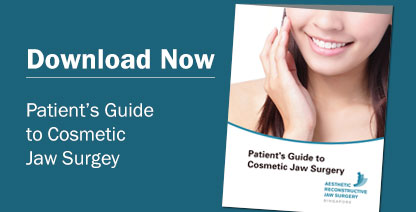Share this
What cosmetic jaw surgery do I need?
on September 21, 2016

The advent of the internet has done much to decrease the information asymmetry between patient and doctor. Having the information is one thing but joining the dots to complete a picture is another. The wealth of information that is freely available on the web can be overwhelming. Cosmetic jaw surgery patients are generally youngish and most would have done some homework prior to coming in for a consultation. Once in a while I get some who are medical website junkies who scour the net for information and form their own diagnosis. They email in their own diagnosis and the treatment that they want and ask for a quotation. Most of the time, I either do not reply or simply tell them that I can’t comment until after a physical examination. Fortunately, the vast majority of patients are not like that. Most patients will ask the question, “What cosmetic jaw surgery do I need?”
That is a good starting point. What the patient needs to tell me is what she feels is wrong and what is the ideal outcome that they are seeking. My job is to find a way to get her from what she looks like to what she hope to look like. And if the objective is not realistic or undesirable, to tell her so.
The "problem"..
The “problem” verbalized by the patient is the most important. Some patients may have a very obvious dentofacial deformity to me but they may not be bothered by it. As dentofacial deformities have both a functional and a cosmetic component, I would seek first to address the functional problems and in the process correct the cosmetic deficit. However, some deformities have no functional problem, e.g. bimaxillary protusion, vertical maxillary excess, some types of facial asymmetry. For these patients, it is even more important that the patient describe in no uncertain terms, what cosmetic outcome they want.
Function:
For those with a functional deficit, e.g. underbite, overbite, open bite, diagnosis is more straightforward. For those without, arriving at the correct diagnosis takes a bit more discussion. What do we look for when examining a face for aesthetics?
Symmetry & Proportions
In general, when assessing the face for aesthetics, we first look for symmetry, or rather, for signs of gross asymmetry e.g. deviation of the chin point to one side, a significantly larger side, etc. Next, we look at proportions. There are general rules like the “rule of thirds”, whereby we divide the face into upper, middle and lower thirds, which in an ideal situation should have similar dimensions. “The rule of fifths” divides the face vertically into five equal parts, with the width of the eyes and nose being equal. Conformation to these proportions gives a natural look to the face. Other than frontal examination, profile assessment is important as well. Conditions like underbite and overbite are more obvious in profile view.
After ascertaining the general proportions and symmetry, we turn to assess the contours of the face and neck. For example, how prominent are the cheekbones, the bony rims around the eyes, the angle of the lower jaw, etc, have a bearing on the over character of the face. Some people prefer angular and defined facial features, while others may like to have them soft and rounded. This is also the area where there are significant differences between male and female and between Eastern and Western preferences.
Features
Next, we will assess the individual features of the face i.e. the eye, nose, ears, mouth, lip, and skin. These facial features are surrounded by mimetic muscles that give the face expressions. As such, an aesthetic assessment of the face is not complete without evaluating the appearance in animation. In particular, we assess the smile, how animated it is, how much gum is showing on smiling compared with when at rest, whether the smile is symmetrical, etc. For the orthognathic surgery age group, skin problems such as acne may worsen during the recovery period. For the older patient, laxity of skin, pigmentation, etc is also noted.
Intraoral & Masticatory
Finally, we check the intraoral condition. The general oral hygiene is noted along with whether there are any periodontal problems. We also check the mucosa of the mouth for any diseases such as lichen planus or inflammation. The individual teeth are also checked for decay, chips and fractures. Front teeth are assessed for intrinsic staining such as tetracycline staining or fluorosis. The occlusion is assessed not just in centric but in lateral movements as well. The temporomandibular joints are assessed for any pathology or derangement such as clicks and crepitus. Maximal mouth opening is measured and path of opening is also documented.
X-rays
Radiographic assessment is done using a cone beam CT scan of the facial bones. With this, the facial bones can be assessed in three dimensions segmentally as well as in the form of a 3D model generated by the software.
Diagnosis
Combining the findings of the physical examination with the radiographic evaluation, we narrow down to a list of diagnoses. From this list, some need to be treated, others are nice to do, but a few are best left untouched. The decision is made based on what the patient wants and the risks associated. Personally, I prioritize function before aesthetics but some patients may not.
Treatment
Orthognathic surgical procedures gives a lasting change as it alters the skeletal base upon which the muscles and skin are attached. Grossly asymmetrical jaws can be made more symmetrical, protruding jaws can be pushed back and retruded jaws can be brought forward. The type of surgery needed depends on the diagnosis as well as the patient’s preference.
There are many tools in our arsenal to correct facial disharmonies. In cosmetic jaw surgery, we are generally referring to surgery of the facial bones, correcting its position, contour and size. However the objective is to effect a change in facial appearance. Depending on the degree of change desired, the choice of surgery could be very different. Cosmetic jaw surgery can be combined with soft tissue surgery such as blepharoplasty, or rhinoplasty. Sometimes, instead of cutting the jaw bone to shift its position, putting in a facial implant may achieve the same result with lower morbidity. Non-invasive procedures such as Botox injections have also effectively replaced surgeries such as masseter muscle reduction for correcting square faces.
Ultimately, the type of surgery needed depends on the diagnosis. A thorough workup is of paramount importance but a detailed discussion between the surgeon and the patient is equally important, especially for the aesthetic aspects fo the surgical plan.
Share this
- Jaw Surgery (93)
- Dental Implants Singapore (90)
- Orthognathic Surgery (48)
- Replacing Missing Teeth (26)
- Missing Teeth Options (23)
- Underbite (23)
- Bone Grafting (21)
- Costs (18)
- Facial Aesthetics (18)
- Aesthetics (17)
- dental implants (16)
- corrective jaw surgery (15)
- BOTOX (11)
- Dermal Fillers (11)
- Wisdom teeth (10)
- Fixed Implant Dentures (8)
- Loose Dentures Singapore (6)
- Medisave (6)
- sleep apnea (6)
- Braces (5)
- Dental Pain (5)
- Dentures in Singapore (5)
- Loose Teeth (5)
- Tooth Extraction (5)
- jaw deformities (5)
- bimax (4)
- bone graft (4)
- maxillomandibular advancement (4)
- all-on-4 (3)
- bimaxillary protrusion (3)
- chin implant (3)
- facial asymmetry (3)
- full mouth dental implants (3)
- genioplasty (3)
- immediate implant (3)
- removal of an integrated dental implant (3)
- third molars (3)
- wisdom tooth surgery (3)
- My Dentures Don't Fit (2)
- VME (2)
- bone graft healing (2)
- distraction osteogenesis (2)
- medical tourism (2)
- obstructive sleep apnea (2)
- orthodontics (2)
- plastic surgery (2)
- CT guided dental implants (1)
- Double jaw surgery (1)
- Invisalign (1)
- Periodontal Disease (1)
- Permanent Dentures Singapore (1)
- before and after photos (1)
- facial trauma (1)
- fractured dental implant (1)
- oral appliance therapy (1)
- root canal treatment (1)
- veneers (1)
- vertical maxillary excess (1)
- September 2019 (2)
- July 2019 (2)
- May 2019 (2)
- August 2018 (1)
- October 2017 (1)
- September 2017 (2)
- August 2017 (1)
- June 2017 (2)
- May 2017 (4)
- April 2017 (1)
- March 2017 (1)
- February 2017 (3)
- January 2017 (3)
- December 2016 (1)
- November 2016 (2)
- October 2016 (4)
- September 2016 (9)
- August 2016 (5)
- July 2016 (11)
- June 2016 (14)
- May 2016 (6)
- April 2016 (2)
- March 2016 (1)
- January 2016 (7)
- December 2015 (10)
- November 2015 (4)
- October 2015 (9)
- September 2015 (7)
- August 2015 (1)
- July 2015 (6)
- June 2015 (3)
- May 2015 (7)
- April 2015 (5)
- March 2015 (8)
- January 2015 (5)
- December 2014 (7)
- November 2014 (7)
- October 2014 (6)
- September 2014 (8)
- August 2014 (5)
- July 2014 (7)
- June 2014 (8)
- May 2014 (9)
- April 2014 (10)
- March 2014 (6)
- February 2014 (8)
- January 2014 (3)
Subscribe by email
Email subscription




Comments (2)